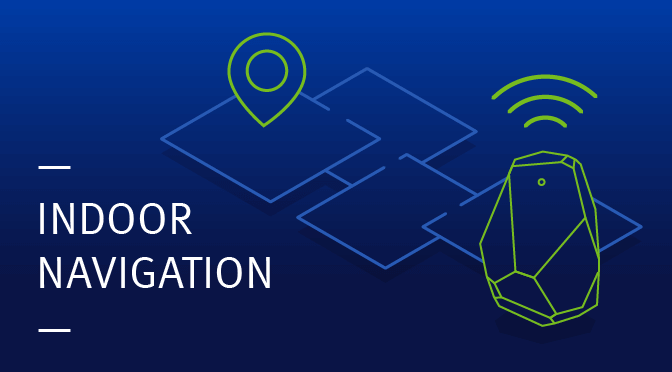From built-in car navigation, to GPS guided mobile city maps that guide you through the city: Could you imagine the world without navigation systems? But there are things when even navigation systems reach their limits – for example inside buildings or areas, because they can’t receive GPS. Beacons are the solution to making navigation inside buildings possible. For questions like “Where is the nearest toilet?” or “Where can I find the elevator in this shopping mall?” they can give you the answer, or more precisely, determine your location. There are several ways to do this, but in this blog post I’d like to explain indoor navigation using beacons. This technology may not be a new invention, but it’s still worth taking a closer look, because practical use cases, at least with beacons, are rarely at the moment.
HOW DOES INDOOR NAVIGATION WITH BEACONS WORK?
Indoor navigation itself means navigation inside buildings and basically works like any ordinary car navigation system, except that the location can’t be determined via GPS. As mentioned above, this happens with the help of beacons. Beacons are small Bluetooth devices that are installed at several points within the building and send signals to the smartphone. The smartphone measures the signal strength and can therefore show the position in a custom-developed navigation app. The accuracy lies between one and two meters and the range of a beacon can be up to 50 meters, depending on the signal strength and the manufacturer and class used.
THE USE OF INDOOR NAVIGATION WITH BEACONS FOR THE CONSUMER
Imagine you are in a huge shopping mall and have to find the Adidas shop among hundreds of stores. That would take quite a long time. With an indoor navigation app that’s no problem. The beacon determines your location and the app navigates you to the Adidas Shop or other Points of Interest (POI) such as attractions, products, taxi ranks, toilets, etc. A particularly nice example of indoor navigation is the Dubai Mall app. It also displays offers and information such as opening hours for the individual POIs. Another special feature is the parking navigation. To avoid long walking times, you can let yourself be led to a parking spot near your desired store and if you lose the overview in the over thousand parking lots, don’t panic, the app leads you to your parking place. The only requirement to use this app is Bluetooth and a smartphone.
But this technology is not only suitable for huge shopping malls. Universities, airports, hospitals and logistics centers can also benefit from it, because indoor navigation offers more than just a simple navigation system.
USE CASES AND TECHNICAL POSSIBILITIES
Accessibility for visually impaired
Even for sighted people it is often difficult to find their way around shopping centers or clinics, and an even greater challenge for many visually impaired or blind people. Outdoors they can largely rely on navigation systems and tactile guidelines. Inside buildings, they have to trust their senses or other people. This is precisely where indoor navigation fills a large gap in the market. An app can be created or adapted especially for blind people. If, for example, a guide dog is carried along, a possible different obstacle-free path is indicated. Disabled persons can also be guided to a barrier-free seat.
Positioning in the mining industry
Indoor navigation can also avoid dangerous situations – for example in the mining industry. The workers are equipped with a beacon in the form of a bracelet or chip card. Beacons must also be attached in the mine itself. If, for example, an employee approaches a dangerous area, he or she will be notified immediately. This can save lives. The beacons can also be used in emergency situations to determine whether an employee is still in a dangerous situation. There are certainly many critics, but the use of beacons doesn’t happen without the worker’s knowledge and offers great added value in such situations.
Asset tracking
X-ray equipment is expensive and shouldn’t get lost, but even the disappearance of a lifting cart can lead to production stops and thus cause high costs. Indoor navigation with beacons enables not only the positioning of people in buildings, but also of goods. In large warehouses, you could equip all moving objects with a beacon and track them. In an app the employees can then look up in which hall or corridor the lifting cart is located and thus save themselves the long search.
Proximity marketing
Many shops have the same problem: countless pedestrians pass by, but no one enters the shop. This is where proximity marketing gets important. Beacons make it possible to send push notifications. In this way you can also integrate advertising or products into an indoor navigation app. As soon as a pedestrian passes the shop, he gets a message, like for example: Today -20% on make-up products!
Indoor navigation and the beacon technology are still relatively unknown in Austria, which does not mean that there is no demand. There are countless use cases and also the possibilities for the technical implementation of indoor navigation, such as with Augmented Reality instead of a building plan, laser navigation instead of beacons, etc. are manifold.
Has this blog post aroused your interest in indoor navigation, or are looking for a partner to help you implement it? Our Anexia experts will be pleased to advise you, without obligation.
